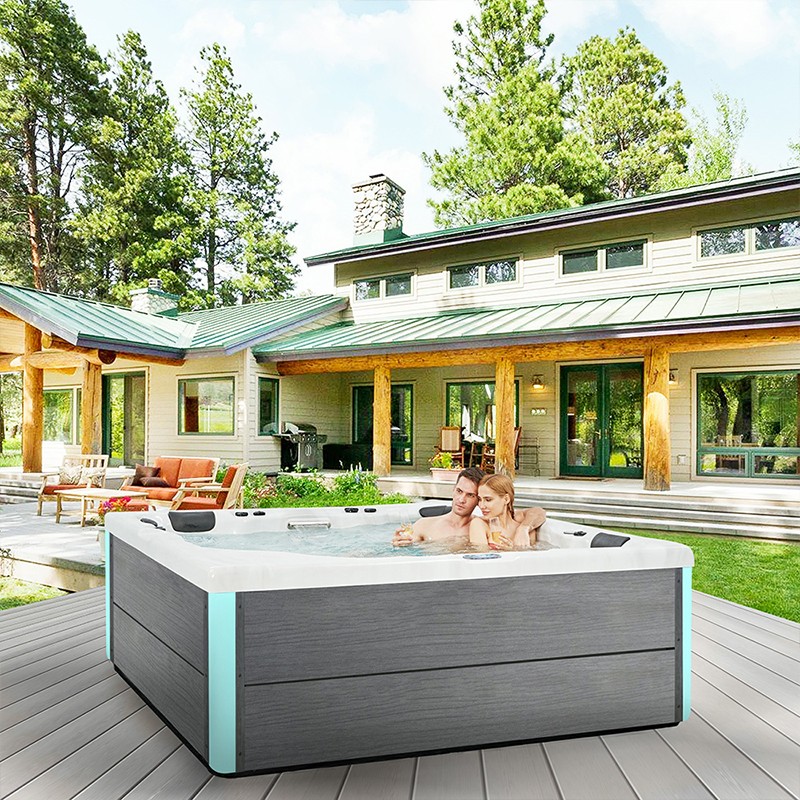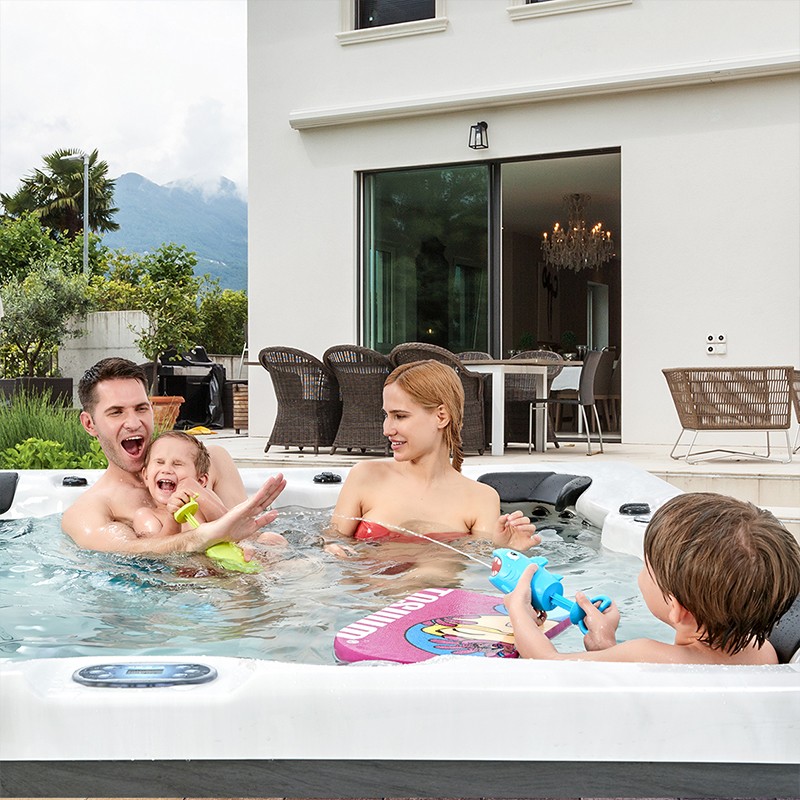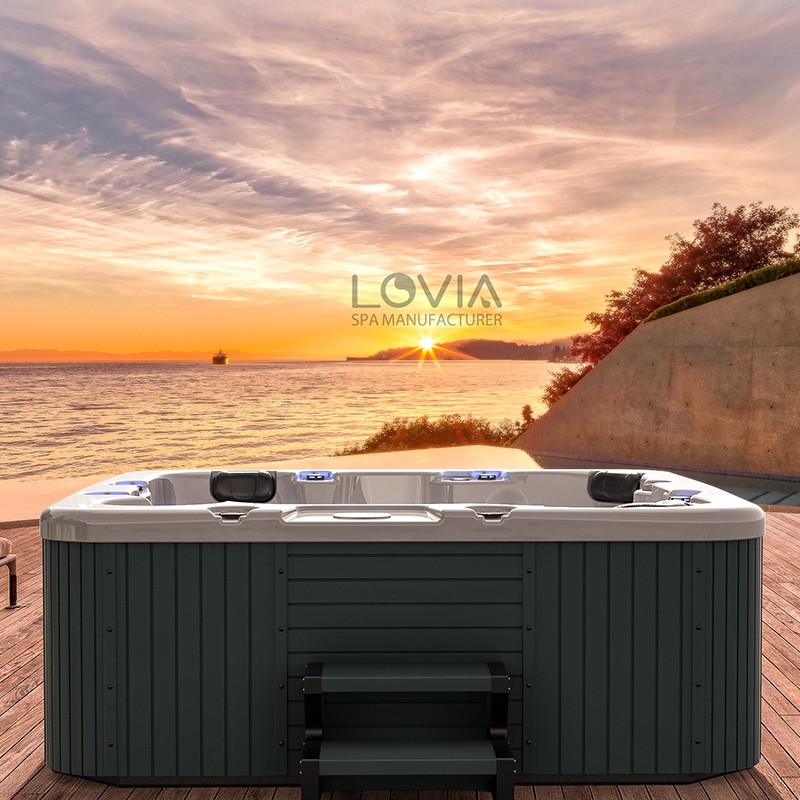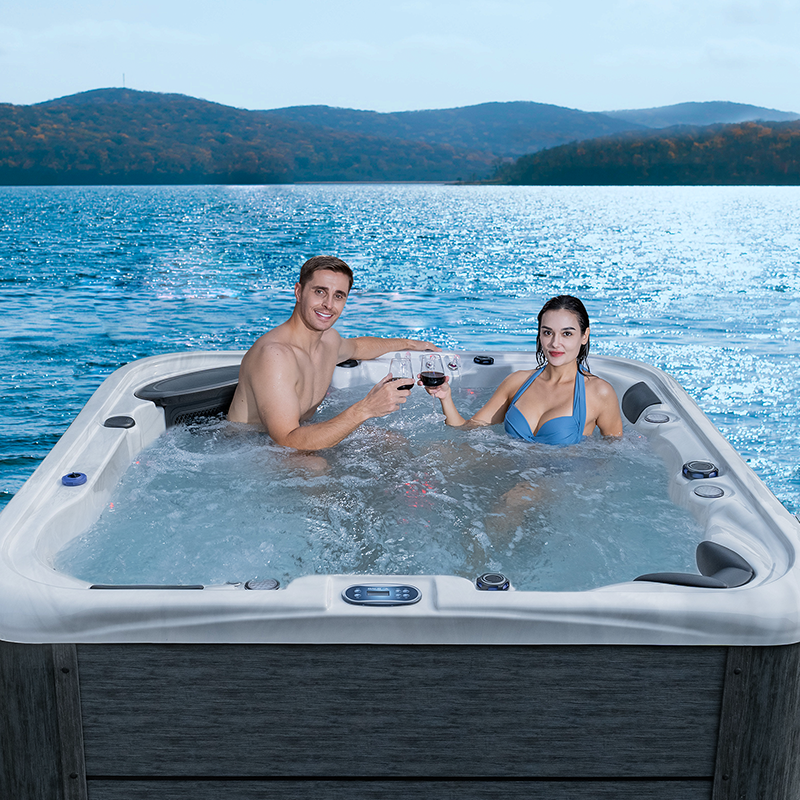
What's the First Step After Refilling a Whirlpool Spa Hot Tub?
2025-11-21 15:35A whirlpool spa hot tub is a luxurious home appliance that promotes relaxation, improves blood circulation, and relieves stress, providing ultimate comfort. However, to ensure the whirlpool spa hot tub remains safe, hygienic, and performs optimally, regularly changing and refilling the tub water is an essential maintenance step.
But what should you do first after refilling the whirlpool spa hot tub?
The answer is: test the water's pH level.
This article will delve into several key questions, including "Why test the pH level after refilling a whirlpool spa hot tub?", "How to correctly test and adjust the pH level", "What problems can pH imbalance cause?", and "What steps are needed after testing the pH level?"

Why Test the pH Level After Refilling a Whirlpool Spa Hot Tub?
Refilling a whirlpool spa hot tub may seem like just changing the water, but in reality, the water composition may differ each time it's filled. The mineral and carbonate content of tap water, well water, or filtered water varies greatly, and these factors directly affect the water's pH balance.
pH value represents the acidity or alkalinity of water and is a core indicator determining the water quality balance of a whirlpool spa hot tub.
• When the pH is too low, the water is acidic, which can corrode components such as heaters, nozzles, and seals.
• When the pH is too high, the water is alkaline, leading to scale buildup, water turbidity, and reduced effectiveness of disinfectants (such as chlorine or bromine).
Therefore, after refilling the whirlpool spa hot tub, testing and adjusting the pH is the first step to ensure stable water quality and the lifespan of the equipment.
This not only relates to user skin comfort and safety but also affects the long-term maintenance of the entire hot water circulation system.
What does pH value mean for a whirlpool spa hot tub?
Chemically, the pH range is 0 to 14:
• 7 is neutral;
• Less than 7 is acidic;
• Greater than 7 is alkaline.
For a whirlpool spa hot tub, the ideal pH range is between 7.2 and 7.8. This is the balance point that ensures the water quality neither corrodes the equipment nor forms scale.
When you refill the whirlpool spa hot tub, the water source may come from different regions, and the alkalinity and mineral content of different water sources vary greatly. For example:
• Tap water in some areas is alkaline, with a pH as high as 8.2 or even higher;
• Well water in some areas is acidic, with a pH value as low as 6.5.
If you add disinfectants or start the heating system directly without testing, the water quality may quickly become unbalanced, causing a series of problems, such as:
• Increased foaming
• Cloudy water
• Corrosion of metal parts
• Skin and eye irritation
Therefore, testing the pH is not only the starting point for maintaining the hygiene of the whirlpool spa hot tub, but also crucial for ensuring the healthy operation of the system.

How to correctly test the pH value of a whirlpool spa hot tub?
There are three main methods for testing pH, suitable for different users' needs and accuracy requirements.
1. Using pH Test Strips (Most Common)
pH test strips are an economical and convenient method. Simply immerse the strip in water for a few seconds and compare it to a color chart to obtain the pH value.
This method is suitable for quick daily testing by home users.
Steps:
• Take a water sample in a clean container.
• Immerse the pH test strip in the water sample for approximately 1–2 seconds.
• Remove and compare with the color chart on the packaging.
• Record the value and determine if adjustments are needed based on the result.
• Advantages: Low price, quick operation.
• Disadvantages: Limited accuracy, significantly affected by light.
2. Using a Digital pH Meter (Professional and Precise)
Digital pH meters provide accurate values, especially suitable for users who frequently use whirlpool spa hot tubs.
Simply place the probe in the water for a few seconds, and the value will be displayed on the screen.
• Advantages: High accuracy, reusable.
• Disadvantages: Requires regular calibration and maintenance, slightly more expensive.
3. Using a Comprehensive Testing Kit
Some brands offer spa testing kits that can test not only pH but also alkalinity, chlorine levels, and other indicators simultaneously.
These kits are very helpful in maintaining overall water quality balance.

How to Adjust pH When it's Abnormal?
After completing the tests, you may find that the pH value deviates from the ideal range. Adjustments should be made based on the test results.
1. Low pH (Acidic Water)
If the pH value is below 7.2, a pH increaser, also known as sodium carbonate or sodium bicarbonate, should be used.
After adding, start the circulation system of the whirlpool spa hot tub to ensure the chemicals are fully dispersed.
Adjustment Steps:
• Calculate the required amount according to the product instructions.
• Slowly pour the increaser into the whirlpool spa hot tub.
• Run the circulation pump for 20 minutes.
• Test the pH value again, repeating the process if necessary.
2. High pH (Alkaline Water)
If the pH is higher than 7.8, a pH decreaser should be used. A common ingredient is sodium bisulfite.
Adjustment Steps:
• Calculate the amount to add based on the bathtub capacity and test results.
• Evenly sprinkle the decreaser into the hot water.
• Circulate for at least 15–30 minutes.
• Test again to ensure the pH is stable between 7.2 and 7.8.
Why is pH balance crucial for disinfection effectiveness?
Many whirlpool spa hot tub users mistakenly believe that adding enough chlorine or bromine will keep the water clean. However, if the pH is not within the correct range, the disinfectant's efficiency will be significantly reduced.
For example:
• At pH 7.5, chlorine's bactericidal efficiency is approximately 50%;
• When the pH rises to 8.0, the bactericidal efficiency drops sharply to 25%.
This means that even if you add the standard amount of chlorine, it may still not effectively kill bacteria and algae.
Conversely, if the pH is too low, chlorine will become overactive, causing skin irritation, eye discomfort, and even equipment corrosion.
Therefore, monitoring and maintaining the correct pH is a prerequisite for ensuring the efficient operation of the whirlpool spa hot tub disinfection system.
What steps are needed after testing the pH?
Testing and adjusting the pH is only the first step. After completing this step, you should continue with the following steps to ensure the whirlpool spa hot tub is in ideal condition.
1. Test Total Alkalinity (TA)
Total alkalinity acts as a "buffer" to maintain pH stability.
The ideal alkalinity range is 80–120 ppm. If the alkalinity is too low, the pH will fluctuate drastically; if the alkalinity is too high, the pH will be difficult to adjust.
It is recommended to test the alkalinity immediately after the pH stabilizes and add sodium bicarbonate as needed.
2. Add Disinfectant
The optimal time to add chlorine or bromine is after the pH and alkalinity have reached equilibrium.
At this point, the disinfectant will work effectively, ensuring the water in the whirlpool spa hot tub is clear, transparent, and odorless.
3. Check Calcium Hardness
Both hard and soft water can affect the equipment. The ideal calcium hardness is 150–250 ppm.
Too low calcium will corrode heating elements, while too high calcium will cause scaling.
Checking calcium hardness after pH testing helps in comprehensive water quality balance control.
4. Start the Circulation System
After adding all chemicals, run the system for at least 30 minutes to allow them to mix thoroughly in the whirlpool spa hot tub.
Observe for foam, turbidity, or sediment. If any appears, retest and fine-tune the pH.
What specific problems can pH imbalance cause?
1. Damage to Equipment
When the pH is too low, acidic water will corrode metal components, pump shaft seals, and heating elements, leading to premature aging and even leaks.
When the pH is too high, alkaline water will cause scaling in heaters and pipes, reducing heating efficiency.
2. Effects on Human Health
An imbalanced pH can not only cause dry, itchy skin, but may also irritate the eyes and respiratory tract.
Especially when the pH is low, acidic water can cause a stinging sensation for sensitive skin.
3. Impact on Water Appearance
High pH can lead to cloudy water, increased foam, and algae growth. Low pH makes the water feel "hard" and has a metallic taste.
These all affect the overall spa experience.

How to maintain a stable pH in the whirlpool spa hot tub?
• Regular testing: It is recommended to test the pH at least twice a week.
• Keep the filter clean: A dirty filter can affect circulation and chemical distribution.
• Avoid excessive chemical additions: Follow the principle of "small amounts, many times" for adjustments.
• Control usage frequency and number of users: Too many people or frequent use can accelerate changes in water quality.
• Completely change the water every 3–4 months: and retest and adjust the pH.
Why do I need to retest the pH every time I refill the whirlpool spa hot tub?
Because different water sources have different mineral and carbonate contents, which directly affect the pH balance. Retesting ensures the initial state is correct.
Can I adjust the pH before heating?
Yes, and it should be adjusted before heating. Increased temperature alters the rate of chemical reactions, so it's best to adjust the pH in cold water first.
What is the best time to test the pH?
The best time to test is 10–15 minutes after the whirlpool spa hot tub has finished circulating, when the water quality is uniform.
What if the pH changes too quickly?
This is usually due to insufficient alkalinity. The total alkalinity (TA) should be adjusted to 80–120 ppm first, then the pH should be fine-tuned.
Can I use a household pH meter (such as one for aquariums)?
Yes, but you need to ensure it is calibrated correctly. It is recommended to purchase testing equipment specifically designed for whirlpool spa hot tubs to ensure accurate data.
Can LOVIA SPA Products Be Used in Hotels or Resorts?
Yes, LOVIA SPA hot tubs and swim spas are ideal for hotels, villas, and resorts. Their stylish design, reliable Balboa controls, and powerful hydrotherapy jets create a premium experience for guests. We supply customized models for commercial use with reinforced shells and longer-lasting components.
As a professional manufacturer and exporter, we offer attractive wholesale prices for bulk hotel purchasing.
